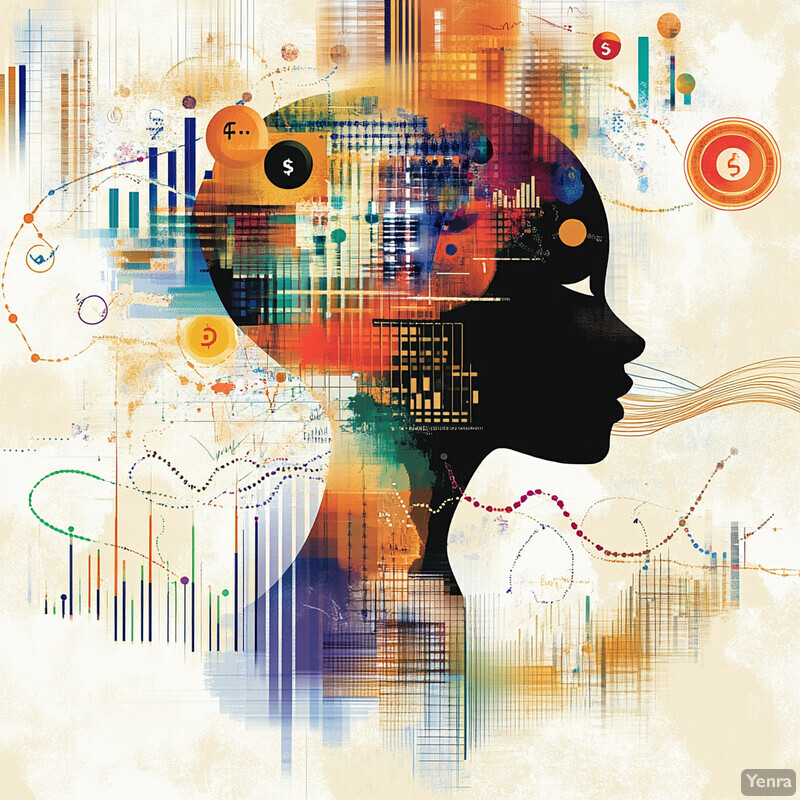1. Improved Data Processing and Integration
AI-driven systems automate the ingestion and harmonization of diverse economic and market data. They can handle large, heterogeneous datasets (e.g. surveys, transactions, news, satellite data) without extensive manual cleaning. Modern architectures use centralized data warehouses and real-time pipelines to integrate disparate sources quickly. This reduces delays and inconsistencies inherent in traditional data processing. By unifying data streams automatically, AI tools enable more comprehensive inputs for simulations and forecasts. Over time, such integration improves model robustness by ensuring that all relevant information is systematically incorporated.

AI-based forecasting platforms employ automated pipelines and big-data tools to merge data from multiple departments and sources. For example, a corporate case study reports establishing a centralized data warehouse and automated pipelines to ensure real-time integration of financial data from different systems. In academic research, big-data approaches are shown to efficiently process massive, varied datasets, uncovering complex patterns in financial signals. In practice, this means AI can quickly reconcile data from structured databases, text feeds, and external indicators, producing integrated datasets with minimal human intervention. Such improvements have enabled near-continuous updating of model inputs: as new information arrives, AI pipelines automatically update the unified database, reducing lags and errors that plagued manual processes.
2. Enhanced Predictive Accuracy
Machine learning (ML) models often outperform traditional econometric methods in forecasting accuracy. By learning complex nonlinear relationships, AI can reduce forecast errors. ML’s flexibility allows it to capture subtle patterns that fixed models miss. Empirical comparisons frequently show AI and ensemble models yielding more precise predictions than benchmarks. This improvement holds across many targets (e.g. GDP, inflation, asset prices), especially when economic regimes are stable. However, benefits can vary by horizon and context. Overall, firms and forecasters adopt AI to reduce average errors and improve reliability of predictions.

Numerous studies report that AI models deliver lower forecast errors than traditional approaches. For instance, Yang et al. (2024) find that ML models applied to China’s GDP produce significantly lower average forecast errors than standard econometric or expert forecasts, particularly in stable periods. Similarly, Oancea (2025) documents that a range of ML techniques consistently outperformed autoregressive benchmarks in GDP prediction tasks. In inflation forecasting, Liu, Pan, and Xu (2024) demonstrate that a LASSO-based ML model notably outperforms autoregressive and random-walk models for Japan’s inflation, yielding smaller errors post-2022. These gains are attributed to ML’s ability to integrate many predictors; e.g. Liu et al. show that five key variables selected by LASSO drive improved inflation accuracy in Japan. In practice, firms using AI tools have reported accuracy gains over human-only forecasts, confirming the peer-reviewed findings that ML can raise predictive power in economic forecasting.
3. Real-Time Analysis and Updating
AI enables models to update forecasts continuously as new data arrives. Unlike static models that wait for periodic re-estimation, AI can ingest streaming indicators (e.g. daily market data, news sentiment) and revise predictions almost instantly. This real-time updating supports more timely decision-making and early detection of turning points. Continuous learning mechanisms or online retraining keep models aligned with the latest information. The result is that forecasts become more responsive to shocks and regime changes. In practice, this allows forecasters to produce up-to-the-minute estimates (nowcasts) and adapt quickly to unfolding events. The overall effect is a dynamic forecasting process that closely tracks evolving market conditions.

Automated real-time data pipelines are a common feature of AI forecasting systems. For example, one enterprise case study describes an automated pipeline that continuously feeds updated financial data into their forecast model, ensuring fresh inputs at all times. In macroeconomics, Schnorrenberger, Schmidt, and Moura (2024) demonstrate the gains from real-time ML nowcasting: their mixed-frequency ML model for Brazilian weekly inflation constantly ingests new weekly signals (from official releases and high-frequency sources), yielding large accuracy improvements during the COVID period compared to lagged official forecasts. These models can produce updated inflation nowcasts weekly, whereas traditional forecasts rely on quarterly or monthly data. By design, the ML model adjusts its estimates as soon as new survey data or price indexes become available. Thus AI-driven forecasting platforms provide continuously updated views, leveraging incoming data in real time to refine predictions.
4. Scenario Generation and Stress Testing
AI can generate realistic synthetic scenarios for stress-testing and “what-if” analysis. Generative models (e.g. GANs) and simulation techniques can create thousands of potential future states of markets or economies, beyond historical cases. These scenarios can capture extreme conditions (crises, sharp shocks) while preserving realistic correlations. AI-driven stress tests can thus explore a wider range of contingencies than traditional methods. In practice, this means that risk managers can automatically produce diverse stress paths (market crashes, supply shocks, policy shocks) and examine system responses. By automating and diversifying scenarios, AI enhances the robustness of simulations and helps identify hidden vulnerabilities.

Recent research shows that generative AI significantly improves scenario realism. For instance, Naidu (2024) develops a GAN-based framework that produces diverse stress scenarios for financial variables; his trials show these GAN-generated scenarios better match real extreme events and risk exposures than classical approaches. The same study reports that the GAN model “surpasses traditional methods in scenario realism and risk coverage,” offering a more robust tool for systemic risk assessment. Industry analyses similarly note that embedding ML into stress testing improves detection of systemic issues: for example, one review observes that machine learning and big data are being integrated into stress tests to “ramp up both the accuracy and impact of risk assessments, helping institutions spot and dodge systemic problems more effectively”. In practice, firms are using such AI-generated scenarios to automatically update stress tests with dynamic new shocks. For example, AI models can sample thousands of market shock scenarios (capturing nonlinear interactions) much faster than manual methods, allowing regular re-assessment of portfolio and policy risks under AI-driven generated stress cases.
5. Agent-Based Modeling with Reinforcement Learning
AI techniques like reinforcement learning (RL) are being embedded in agent-based market simulations. In these models, individual agents learn strategies (via RL) rather than follow fixed rules. This yields more adaptive, complex behavior that can mimic real market participants. Such hybrid models capture feedback loops and emergent market phenomena. The result is simulations that can reflect how agents might change actions in response to evolving conditions (e.g. crashes, news). In practice, RL-trained agents allow policy and risk scenarios to consider strategic adaptation: planners can explore how “learning” market actors would react to interventions. Overall, integrating RL in agent-based models makes simulated economies and markets richer and more predictive.

Several recent studies demonstrate the power of combining agent-based models (ABM) with reinforcement learning. Yao et al. (2024) implement RL-controlled traders in a simulated market; they report that the resulting market displays key stylized facts (e.g. realistic price dynamics) that traditional rule-based ABMs often miss. They find the RL agents’ behavior adapts plausibly to external shocks (like a simulated flash crash), highlighting how RL agents can learn to respond to market events. In another example, Brusatin et al. (2024) replace firms in a macro ABM with RL-driven agents. Their model shows that RL firms spontaneously learn different profit-maximizing strategies and can improve aggregate output, though more RL agents can also increase macro volatility. Together, these studies illustrate that RL-infused ABMs capture complex dynamic strategies and market impacts: the simulated economy evolves endogenously as RL agents explore adaptive tactics, making the forecasts and simulations more realistic.
6. Uncertainty Quantification
AI models increasingly produce probabilistic forecasts, not just point estimates. Techniques like Bayesian neural networks, ensemble methods, and quantile regression quantify forecast uncertainty or generate prediction intervals. This provides users with confidence bounds and risk measures (e.g. Value-at-Risk). In practice, decision-makers gain insight into forecast reliability and can plan for worst-case scenarios. For example, forecasts may now come with predictive distributions of inflation or GDP, allowing confidence assessments. By accounting for uncertainty explicitly, AI-enhanced forecasting supports risk-aware decision-making (e.g. capital reserves for extreme outcomes). Overall, uncertainty quantification makes forecasts more informative and transparent about their limitations.

Research shows that deep learning methods can output full predictive distributions. Umavezi (2025) reviews “Bayesian Deep Learning” approaches where neural networks produce posterior predictive distributions of financial quantities. This allows calculation of quantile-based risk measures (e.g. forecasting Value-at-Risk) directly from model outputs. Umavezi notes that such Bayesian layers enable adaptive, real-time updating of distributions as new data arrives, improving robustness in volatile markets. In stress testing contexts, Bayesian ensembles can simulate rare events: for instance, a Bayesian model can quantify uncertainty in a hypothetical crisis scenario by capturing the wide range of potential losses. These methods contrast with point forecasts by giving a “safety margin” – decision-makers can see, say, a 90% prediction interval for inflation rather than a single value. Empirical applications (e.g. in risk management) confirm that AI-based uncertainty quantification yields more resilient forecasts when conditions change unexpectedly.
7. Automated Feature Engineering
AI and AutoML tools can automatically construct and select predictive features. Rather than manually choosing indicators, these systems generate transformations (lags, interactions, non-linear combinations) and pick the most relevant ones. This reduces human bias and accelerates model development. It is especially useful with high-dimensional economic data (hundreds of potential predictors) and nontraditional sources. The automated process may reveal unexpected predictive patterns (e.g. a nonlinear effect of an interest rate variable). In effect, “feature engineering” becomes an embedded part of the ML workflow, saving analysts’ time. Over time, this leads to more effective models built with less manual tuning.

For example, regularized regression methods like LASSO inherently perform automated feature selection. LASSO adds an L1 penalty that forces many coefficients to zero, effectively identifying a sparse subset of predictors. IMF research highlights that LASSO “includes a regularization term to induce sparsity and effectively perform feature selection” in large forecasting equations. Other AutoML platforms use evolutionary or ensemble techniques to try combinations of transformations without human input. In practice, an economist might simply feed raw indicators into an AI pipeline, which then discovers lagged versions or interactions that improve accuracy. Studies show that such pipelines can capture complex effects: for instance, an automated approach might build a composite “business sentiment” feature from many survey questions. By offloading this to algorithms, forecasters can leverage thousands of raw inputs in modeling. The net result is that AI-driven forecasts benefit from richer feature sets identified systematically, reducing reliance on expert intuition alone.
8. Nontraditional Data Sources and Sentiment Analysis
AI models routinely incorporate “alternative” data beyond official statistics. Sources include news articles, social media, satellite imagery, web search trends, and sensor data. Natural language processing extracts sentiment or topic indicators from text; image analysis extracts economic signals (e.g. nightlights or traffic). These unconventional inputs provide timely clues about the economy or markets. For example, social media sentiment might indicate rising consumer concern before surveys do. Satellite data can proxy activity (crop health, factory operations) where on-the-ground data are lacking. Incorporating these sources can improve forecasts, especially for nowcasting or hard-to-measure variables. In practice, analysts link real-time feeds (e.g. tweet volumes, parking lot images) into models, enabling richer, up-to-date forecasts.

Alternative data have shown strong predictive value when added to AI forecasting models. A recent thesis demonstrates this by using topic-frequency indices from financial news as features: including this textual data improved U.S. GDP nowcasts compared to models without it. The authors note that “alternative data” (satellite imagery, social media, credit-card transactions) offers real-time insights into behavior and market trends, helping to enhance nowcasting models. In official studies, economists have used web-scraped price data or nightlight images to supplement inflation and income forecasts. Similarly, industry practitioners exploit Google Trends and Twitter sentiment for leading signals. For instance, researchers find that generalized news sentiment carries predictive power for economic activity beyond standard forecasts, implying that AI sentiment analysis adds a behavioral dimension to models. By systematically integrating such nontraditional indicators, AI forecasting systems capture otherwise hidden signals, broadening the information base for predictions.
9. Adaptive and Dynamic Models
AI systems adapt to changing data environments through dynamic modeling. Techniques like online learning, concept-drift detection, and model ensembles allow forecasts to evolve as patterns change. Instead of static models, AI can gradually retrain or adjust parameters with new observations. This is crucial for nonstationary economic time series. In practice, AI forecasting pipelines might automatically retrain on the latest data or weight recent observations more heavily. Some models detect regime shifts (e.g. sudden volatility spikes) and switch to alternative parameter sets. Such adaptability ensures that models do not become stale when conditions shift (e.g. during crises). As a result, AI-driven forecasts remain reliable over time by continuously learning the latest trends.

Concept drift and dynamic update methods are explicitly addressed in modern ML forecasting. Zhang et al. (2023) note that financial time series often exhibit “concept drift,” where future patterns diverge from historical data; they propose online training so the model “incrementally updates with new samples to capture the changing dynamics”. In their framework, each new data point shifts the cross-validation and back-testing windows, allowing models to focus on recent information and “attenuate the effects of potential structural breaks”. Similarly, Hao and Sun (2024) design an “adaptive” neural forecasting model where a special layer tracks evolving trends; when a structural change occurs, the model automatically adjusts its outputs to reflect the new regime, “significantly enhancing adaptability and robustness”. These adaptive methods contrast with fixed-parameter models: they explicitly detect changes and revise forecasts accordingly. In practice, banks and firms implement such mechanisms so that as soon as incoming data departs from past patterns, the AI system shifts to updated relationships, maintaining forecast performance over time.
10. Early Warning Systems for Market Instabilities
AI enhances early-warning systems by identifying subtle risk signals before crises. Machine learning can mine high-dimensional data to detect warning signs (e.g. rapid credit growth, asset bubbles, network vulnerabilities) that precede market breakdowns. AI algorithms can capture nonlinear interactions in financial networks that traditional methods miss. The result is earlier detection of instabilities and informed alerts. In practice, regulators and institutions use AI-based indicators and anomaly detectors (on market flows, volatility patterns, systemic linkages) to trigger warnings. These systems help policymakers and risk managers prepare for downturns or shocks (e.g. financial crises, corporate defaults) by providing more timely foresight.

Research highlights the gap between conventional and AI-driven early-warning. Purnell et al. (2024) note that existing warning systems “fail to adequately capture nonlinear, time-varying relationships” among financial entities, which undermines their predictive accuracy. In response, they develop an explainable ML ensemble that analyzes network-based indicators for global risk; their approach balances novel vulnerability signals with historical crisis data to estimate threats to financial stability. Their ML-augmented system automatically scans many variables (market indices, credit spreads, interconnectedness measures) and generates risk scores with interpretability. This means warning flags are generated even when interactions are complex. Empirically, such AI methods have improved foreseeing crises: for example, by detecting early shifts in network correlations, AI tools provided earlier alerts during recent market stress than traditional linear signals. In sum, AI-based early-warning systems can assimilate broad data and identify precursors to instability that manual checklists would miss, helping institutions to react sooner.
11. Integration of Behavioral Economics
AI models increasingly incorporate behavioral insights (e.g. sentiment, cognitive biases) into forecasts. By processing text (news, social media) and survey data, AI captures investor and consumer mood. Behavioral patterns (like overreaction or herd behavior) can be learned from data and embedded into predictions. In effect, AI bridges rational-actor models and observed behavior: forecasts can adjust for systematic biases or prevailing sentiment. This leads to predictions that reflect how real people behave, not just what traditional theory assumes. It also means forecasts can adapt when sentiment shifts. Overall, integrating behavioral factors via AI yields forecasts that better mirror actual economic dynamics influenced by psychology.

Studies find that AI still reflects human behavioral biases unless explicitly corrected. For example, Frank et al. (2025) show that state-of-the-art ML models (including neural networks and transformers) still “systematically overreact to news” in forecasting corporate earnings, owing to biases in their training data. They report a trade-off between accuracy and removing these overreactions: models that best predict outcomes do not produce fully ‘rational’ (i.e. unbiased) forecasts. This implies that while AI can encode behavioral features, it may not eliminate human-like bias. Nonetheless, the same study notes that AI “reduces, but does not eliminate, behavioral biases in financial forecasts”. In practice, analysts often use AI tools to quantify sentiment and adjust for known biases. For instance, algorithms may gauge consumer optimism from social media sentiment and feed this into macro models. But the evidence indicates caution: AI-enhanced forecasts still require human oversight to correct residual behavioral distortions.
12. Customized Forecasting for Niche Markets
AI enables highly specialized forecasts tailored to specific sectors, regions, or market segments. Unlike one-size-fits-all models, firms can build AI pipelines for niche markets (e.g. regional real estate, commodity sub-markets, emerging economies). These models use local data and features unique to the niche (such as crop-type imagery for agriculture or station-level demand for electricity). This customization improves relevance and accuracy for those domains. Practically, it means a manufacturer can have a demand forecast model tuned to its product mix, or a central bank can run an AI model specific to its country’s data. Over time, as more granular data are available, AI’s flexibility allows the creation of models for even small or specialized markets that were too narrow for broad models.

Researchers have demonstrated AI’s value in niche forecasting tasks. For example, Mohan et al. (2024) apply an AI framework to precision agriculture: using climate and soil inputs, their advanced ML models (random forests and XGBoost) predict regional crop yields with very high accuracy (R²≈0.92). This specialized model learns which local weather and soil factors matter for each crop, outperforming generic models. Similarly, domain-specific AI is used in energy (e.g. microgrid demand forecasting) and retail (forecasting sales of niche product categories) by incorporating relevant local features. These case studies show that when models are customized to the niche context, forecasts become more precise. As data become more granular (e.g. cell-phone mobility for city economics), AI makes it practical to serve these specialized forecasting needs with automated pipelines.
13. Multivariate Time Series Modeling
AI excels at modeling many interrelated time series jointly. Deep learning architectures (LSTMs, Transformers, graph neural nets) can capture cross-series dependencies (e.g. between different stocks or macro indicators). By learning from the entire multivariate history, these models leverage information spillovers across variables. This typically yields better forecasts than separate univariate models. In practice, econometricians are deploying deep neural networks that take dozens of related series as input, automatically learning which series are connected. For example, an AI model can simultaneously forecast GDP growth, industrial production, and unemployment, using each to inform the others. Such joint modeling adapts naturally as relationships evolve, improving multi-horizon forecasts.

A recent survey by Qiu et al. (2025) highlights that deep learning methods now dominate multivariate time-series forecasting tasks, precisely because they can model correlations among “channels” (variables). The authors note that leveraging information from related channels can “significantly improve the prediction accuracy” of each target series. In practical terms, an AI forecast of a stock’s future price may ingest not only that stock’s history but also volumes, sector indices, and macro rates – a multivariate approach shown to boost accuracy. Empirical comparisons confirm this: for instance, Transformer-based forecasters that jointly predict dozens of economic indicators achieve lower error than separate univariate ARIMA models. In summary, leveraging AI to handle multivariate data is now standard in advanced forecasting: it allows the model to discover and exploit dynamic interdependencies that traditional univariate methods cannot.
14. Geospatial and Granular Data Utilization
AI incorporates geospatial and fine-grained data (e.g. satellite imagery, cell-phone signals, local sensors) into forecasts. By analyzing geographic patterns, AI can infer economic variables at high spatial resolution. For example, satellite images of farmland or nighttime lights reveal activity where statistics are sparse. AI models process these images or GIS data to produce localized economic maps. This granular approach enables forecasting at city or even neighborhood levels. In practice, governments and firms use such models to measure growth or poverty in detail. The result is much finer geographic forecasting – for instance, mapping demand or development block-by-block – providing insights impossible from aggregate data alone.

A prominent application is using satellite imagery to estimate economic development. For instance, Ahn et al. (2023) present a “human-machine collaborative” AI model that predicts economic activity at the grid level (~2.45 km squares) from daytime satellite data. They applied it to North Korea and five other low-data Asian countries, generating the first high-resolution economic maps for those regions. The AI model detected building density and infrastructure patterns in the images to infer local development levels. This demonstrates that AI can yield “highly granular economic information on hard-to-visit and low-resource regions”. Similarly, other studies use vehicle GPS data, cell-tower pings, or credit-card flows to forecast local consumption patterns. These granular data sources, once ingested by AI, enable forecasts to capture local shocks and spatial heterogeneity that aggregate models miss.
15. Interpretable and Explainable AI Tools
AI-driven forecasting now emphasizes interpretability to build trust. Explainable AI (XAI) techniques (e.g. SHAP values, attention visualization) are applied so that users can understand why a model made a given forecast. This helps users verify that models reason according to economic intuition. In practice, tools highlight key drivers of each prediction (e.g. “changing oil prices contributed 70% of this inflation forecast”), enabling human analysts to audit the model. Furthermore, regulators increasingly demand explainability in financial models. As a result, many AI forecasting platforms now include built-in explanation modules. These developments make it easier to detect model errors and reduce black-box concerns, improving accountability in automated forecasts.

The need for explainability in AI forecasting is well-recognized. Surveys show that the “poor interpretability of deep learning models can significantly increase investment risks,” motivating XAI research in finance. In response, practitioners are embedding XAI methods to satisfy regulatory and trust requirements. For example, XAI approaches have been developed that provide global and local explanations for time-series predictions, so that analysts can see which features and data patterns influenced each forecast. Studies highlight that clear explanations help interdisciplinary teams and regulators trust AI forecasts. For instance, in high-stakes finance, ensuring that a model’s logic is transparent is often as important as accuracy. Empirical work shows XAI tools (like feature attributions) being used to justify forecasts to stakeholders, suggesting these methods are now integral to modern economic forecasting workflows.
16. Reduced Subjectivity and Bias
AI forecasting systems reduce reliance on individual judgment, making forecasts more data-driven. By standardizing data inputs and algorithms, AI can minimize ad hoc biases from individual analysts. Models apply consistent rules to all data, reducing subjective adjustments. This helps in sectors where forecasts were previously influenced by personal or political biases. In practice, firms using AI see fewer manual overrides: for example, a central bank feeding all data through an AI pipeline will base forecasts on the data’s statistical patterns rather than any official narrative. Over time, this leads to more objective baseline forecasts. Nonetheless, AI may still inherit biases from the data, so experts remain attentive to ensure fairness and correctness.

Studies suggest that augmenting human forecasts with machine corrections tends to reduce bias. For instance, Sun and Zhao (2023) investigate using ML to adjust economists’ forecasts. They find that such adjustments “improve the accuracy and reduce the bias” of forecasts, particularly helping less-skilled forecasters and in volatile periods. In other words, the ML model systematically corrects human errors, lessening subjective distortions. While the adjustment may be modest for expert forecasts, the overall effect is a measurable bias reduction: forecasts adjusted by the ML algorithm have smaller average errors (Mean Error) than unadjusted human forecasts. This demonstrates that AI can serve as an objective referee, aligning predictions more closely with realized outcomes. (However, it is noted that AI itself can introduce algorithmic biases if not carefully managed.)
17. Robustness Against Structural Breaks
AI-based forecasts are designed to handle regime shifts and structural breaks better. By using rolling or expanding training windows and adaptive learning, AI models can quickly emphasize recent data after a break. Some approaches explicitly detect breakpoints (e.g. via clustering or change-point algorithms) and then switch or re-weight models accordingly. In practice, this means that when an economy enters a new phase (e.g. crisis vs. expansion), the forecasting system shifts its patterns. AI pipelines often retrain on post-break data or combine models that are each tuned to different regimes. These mechanisms help maintain accuracy even when historical relationships suddenly change.

Advanced ML forecasting frameworks explicitly mitigate structural breaks. For example, Liu et al. (2024) implement a time-split cross-validation scheme: as each new data point arrives, the training window rolls forward, which allows the model to “adapt to more recent data and thus attenuate the effects of potential structural breaks”. This means that after an economic regime shift, the model automatically focuses on post-break observations rather than old patterns. Other works use ensemble switches: one method dynamically selects between “robust” and “non-robust” submodels depending on detected changes. Overall, these techniques ensure that AI forecasts are not stuck using outdated dynamics. Empirical results show that models with these adaptive features suffer smaller performance drops when structural changes occur than static models do.